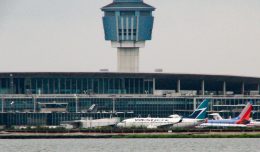Numerous airlines on Tuesday morning were forced to cancel hundreds of flights to and from Scotland and several other regions as the latest volcanic ash crisis continued to intensify.

Grímsvötn eruption at 13:00 UTC on May 22, 2011 captured by the MODIS instrument on NASA's Aqua satellite. (Photo by NASA/GSFC, MODIS Rapid Response)
The ash plume is coming from Grímsvötn, Iceland’s most active volcano, which erupted on late Saturday afternoon at around 5.30 p.m. local time. It is believed to be the volcano’s largest eruption in about 100 years, sending a plume of smoke initially more than 20 kilometers (12 miles) into the air.
While the disruption is not comparable to that of last year when Iceland’s Eyjafjallajökull volcano erupted, the crisis intensified on Tuesday morning when airlines announced the cancellation of more than 500 flights. That number was still expected to rise in the afternoon.
A volcanic ash plume of high density was covering most of Scotland on early Tuesday afternoon, according to models provided by the London Volcanic Ash Advisory Center (VAAC). High density plumes were also covering parts of Iceland, Greenland, Svalbard, and a small part of Russia.
Low and medium density ash clouds were covering all of Ireland, north and northwest England, and a small part of Norway. But flights were not disrupted in areas of low and medium density because new aviation rules introduced after last year’s crisis allow airlines to operate in those areas.
It is unclear how the ash cloud will develop in the coming days and which countries could be affected. “Due to unstable meteorological conditions, it is not possible to identify with certainty the movements of the ash cloud beyond that time frame,” Eurocontrol, the agency charged with coordinating air traffic management across Europe, said.
As of early Tuesday afternoon, a total of 20 airlines reported more than 500 cancellations combined for flights to and from Scotland and in Greenland and Iceland. That number is expected to rise as some airlines had not yet decided on the status of their afternoon flights.
“Forecasts continue to show significant volcanic ash in Scottish airspace,” British Airways said in a brief update on Tuesday. The airline reported a total of 48 flights being canceled between London and Glasgow, Aberdeen, and Edinburgh.
Other airlines which canceled flights to and from Scotland and the number of their cancellations were: CityJet 12, Aer Lingus 20, KLM 34, EasyJet 90, Flybe 52, IcelandAir 2, Eastern Airways 58, AerArann 2, RyanAir 36, Air Southwest 4, British Midland International 39, Jet2.com 2, Loganair 61, Wizz Air 4, Wideroe Airline 14 and Scandinavian Airlines (SAS) 2.
In Greenland, Air Greenland said it canceled 24 domestic flights while Air Iceland announced the cancellation of at least five domestic flights in Iceland.
Irish low-cost airline Ryanair is, like last year, a fierce protester against any cancellations for volcanic ash. “Ryanair strongly objects to this decision and believe that there is no basis for these flight cancellations and is meeting with the [Irish Aviation Authority (IAA)] this morning to have this restriction on Ryanair flights removed as a matter of urgency,” the airline said in a statement.
Ryanair said it operated a 1-hour verification flight up to 41,000 feet (12 kilometers) in Scottish airspace on Tuesday morning without problems despite the area being marked as having a high concentration of volcanic ash.
“There was no visible volcanic ash cloud or any other presence of volcanic ash and the post flight inspection revealed no evidence of volcanic ash on the airframe, wings or engines,” Ryanair said. “The absence of any volcanic ash in the atmosphere supports Ryanair’s stated view that there is no safety threat to aircraft in this mythical ‘red zone’ which is another misguided invention by the UK Met Office and the [UK Civil Aviation Authority (CAA)]. “
But aviation experts disagree, saying that the volcanic ash can result in an aircraft losing its engines. In 1982 and 1989, two Boeing aircraft lost all their engines when flying through a thick cloud of volcanic ash. The planes were able to land safely.
Since the massive flight disruptions last year, airlines in the United Kingdom are now allowed to operate in areas of medium and high density ash if they have a safety case which has been approved by the UK Civil Aviation Authority (CAA). While most airlines will fly with medium density ash, no airline has requested to fly in high density ash clouds which is the case in Scotland on Tuesday.
“Our number one priority is to ensure the safety of people both onboard aircraft and on the ground. We can’t rule out disruption, but the new arrangements that have been put in place since last year’s ash cloud mean the aviation sector is better prepared and will help to reduce any disruption in the event that volcanic ash affects UK airspace,” said CAA Chief Executive Andrew Haines on Monday.
Also on Monday, Eurocontrol said it has for the first time activated the European Aviation Crisis Coordination Cell (EACCC) in order to coordinate a response that can mitigate any potential impact while maintaining established safety levels. EACCC was established by European Union (EU) Transport Ministers in May 2010 to respond to crisis situations.
The EACCC brings together representatives from Eurocontrol, the European Commission, the European Aviation Safety Agency (EASA), the EU Member States and air transport stakeholders. Its main role is to facilitate the management of crisis situations affecting aviation in the European Civil Aviation Conference (ECAC) region.
The EACCC is further responsible for alerting the aviation community to an impending crisis and for proposing, coordinating and implementing the measures required to deal with it. A key function of the EACCC is therefore to keep all aviation stakeholders informed about the crisis, including the decisions that have been taken and the progress of the measures to deal with it.
The Grímsvötn Volcano is situated about 220 kilometers (136 miles) east-northeast of the country’s capital Reykjavik and is located underneath Vatnajökull, Europe’s largest glacier. Eruptions at Grímsvötn are frequent and usually occur with an interval of a few years. Most of these eruptions last a few days and are small in volume.
Historical and geological records show that there have been around 60 to 70 volcanic eruptions over the last eight centuries in the Grímsvötn volcano. The latest eruptions occurred in the years 2004, 1998, 1996, 1983 and 1934. None of these eruptions threatened lives or inhabited areas and all except one are classified as minor eruptions.
Typical eruptions at Grímsvötn last from two to fourteen days and little or limited volcanic ash is associated with these eruptions. Visible volcanic ash rarely reaches farther than the perimeter of the glacier Vatnajökull and effects on commercial air-traffic is usually limited. During the eruption in 2004, restrictions were put on air-traffic to the north of Iceland for five days and trans-Atlantic flights were re-routed to the south of Iceland. No airport closures were in effect.
The volcanic activity in the Grímsvötn volcanic system is periodic, officials say, and active periods last from about 100 to 150 years with more restful periods of a few decades in between. A period of increased activity seems to have started with the eruption in 1983.







